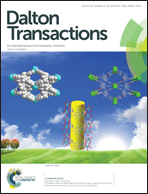Design, synthesis and characterisation of new chimeric ruthenium(ii)–gold(i) complexes as improved cytotoxic agents†
Abstract
Two heterobimetallic complexes, i.e. [RuCl2(p-cymene)(μ-dppm)AuC] (1) and [RuCl2(p-cymene)(μ-dppm)Au(S-thiazoline)] (3), based on known cytotoxic [Ru(p-cymene)Cl2(PR3)] and [AuX(PR3)] (X = Cl, SR) molecular scaffolds, with the diphosphane linker 1,1-bis(diphenylphosphino)methane, dppm, were conveniently prepared and characterised. Remarkably, the new compounds manifested a more favourable in vitro pharmacological profile toward cancer cells than individual ruthenium and gold species being either more cytotoxic or more selective. The interactions of the studied compounds with (pBR322) DNA and their inhibitory effects on cathepsin B were also assessed. In addition, their reactivity toward suitable models of protein targets was explored and clear evidence gained for disruption of the bimetallic motif and for protein binding of monometallic fragments. Overall, the data reported here strongly support the concept of multifunctional heterometallic compounds as “improved” candidate agents for cancer treatment. The mechanistic and pharmacological implications of the present findings are discussed.


 Please wait while we load your content...
Please wait while we load your content...